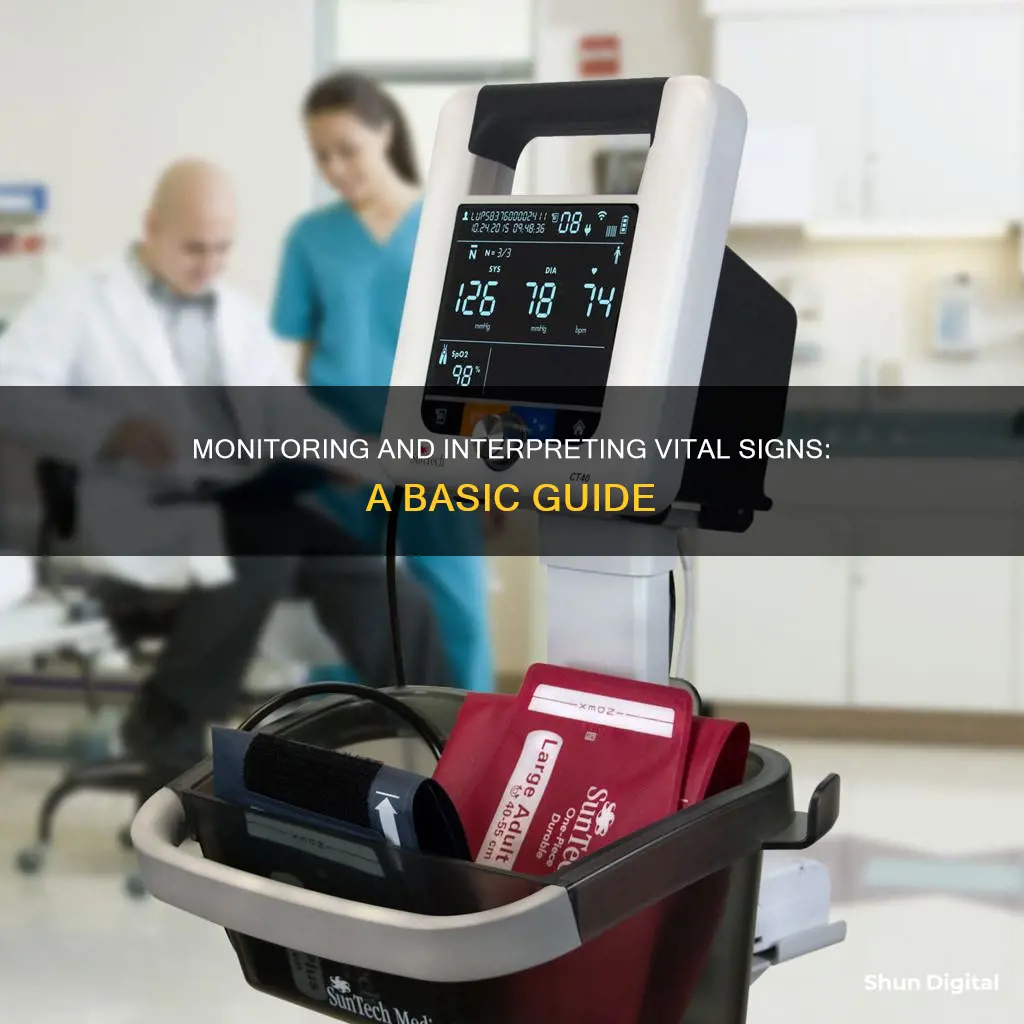
Monitoring and interpreting vital signs is a core skill for healthcare professionals, especially those working in emergency departments. Vital signs are measurements of the body's basic functions, and they include heart rate, respiratory rate, blood pressure, and body temperature. These measurements are typically the first step in any medical evaluation and can be used to detect potential health concerns. They can also help doctors establish a baseline for a patient, allowing them to notice any changes that might indicate an illness or other health issues. For example, a change in a person's baseline measurements could point to an underlying illness or heart issue that has not yet been diagnosed. Vital signs can be measured in a variety of settings, including medical facilities, at home, or at the site of a medical emergency.
| Characteristics | Values |
|---|---|
| Heart rate | 60-100 beats per minute for healthy adults; lower for athletes or highly active people |
| Blood pressure | Systolic: 100-130; Diastolic: 60-80 |
| Body temperature | 98.6°F (37°C); can range from 97.8°F to 99.1°F (36.5°C to 37.2°C) |
| Respiratory rate | 12-16 breaths per minute for a resting adult |
| Oxygen saturation | 95% and above; below 90% indicates insufficient oxygen |
What You'll Learn

How to measure heart rate
Measuring your heart rate is an effective and easy way to assess your health. It can help you monitor your overall fitness level and identify potential heart conditions.
To measure your heart rate by hand, take the pads or tips of your index and middle fingers and gently press them against the side of your neck, just under your jawline. Alternatively, you can press your fingers on the inside of your wrist, below the base of your thumb.
Once you find your pulse, count the number of beats you feel for 15 seconds. Use a stopwatch or timing device to accurately track the seconds. Then, multiply the number of beats by four to get your heart rate for one minute. For example, if you counted 20 beats in 15 seconds, your heart rate would be 80 beats per minute (20 x 4 = 80).
To ensure accuracy, you can repeat the process a few times and calculate an average. Take your heart rate three times, using the method described above, add the three numbers together, and then divide that sum by three. For instance, if you get 80, 84, and 91, the average would be 85 beats per minute ((80 + 84 + 91) / 3 = 85).
It is important to measure your heart rate at the right time. Avoid taking your heart rate after exercising, experiencing stress, or consuming caffeine, as these activities can elevate your heart rate for up to two hours. Ideally, you should be in a comfortable position for at least five minutes before measuring.
Additionally, you can use devices such as smartwatches, fitness trackers, or smartphone apps that automatically measure your heart rate. These devices are convenient and are becoming increasingly accurate over time.
Simple Guide: Setting Up a 144Hz Monitor
You may want to see also

How to measure respiratory rate
The respiratory rate is the number of breaths a person takes per minute. This is one of the main vital signs, along with blood pressure, pulse, and temperature. The normal respiratory rate for healthy adults is between 12 and 20 breaths per minute. At this rate, carbon dioxide exits the lungs at the same rate that the body produces it.
To take an accurate measurement, watch the person’s chest rise and fall. One complete breath comprises one inhalation when the chest rises, followed by one exhalation when the chest falls. To measure the respiratory rate, count the number of breaths for an entire minute, or count for 30 seconds and multiply that number by two.
It is important to measure a person’s respiratory rate at rest. Exercise or even walking across a room can affect it. Normal respiration rates for an adult person at rest range from 12 to 16 breaths per minute.
Respiration rates may increase with fever, illness, and other medical conditions. When checking respiration, it is important to also note whether a person has any difficulty breathing.
Breathing rates of below 12 or above 20 can mean a disruption in the breathing processes. Doctors refer to a high respiration rate of more than 20 breaths per minute as tachypnea. This can be caused by anxiety, fever, respiratory conditions, heart problems, and dehydration.
A low respiratory rate of fewer than 12 breaths per minute is called bradypnea. This can occur as a result of a worsening of an underlying respiratory condition, airway obstructions, and cardiac arrest. It can also be caused by drug overdose, obstructive sleep apnea, and head injuries.
If the respiratory rate is atypical or a person has signs of infection such as fever, fatigue, or a sore throat, they should consult a doctor.
Finding the Right Monitor: A Comprehensive Guide
You may want to see also

How to measure body temperature
Body temperature is an essential vital sign that provides important information about a person's health. The human body, as a warm-blooded species, maintains a relatively constant body temperature, which is crucial for maintaining vital functions and metabolic processes. However, various external and internal factors can cause fluctuations. Here is a comprehensive guide on how to measure body temperature accurately:
- Choose the Body Part: Different body parts can be selected for temperature measurement, each with its own normal temperature range. The most common methods are:
- Rectal Measurement: Inserting a thermometer into the rectum provides the most reliable way to obtain a core temperature value. This method offers high precision and low result variation. The normal temperature range is approximately 36.6 °C to 38.0 °C.
- Oral Measurement: This can be done as a buccal measurement (in the cheek) or sublingual measurement (under the tongue). Oral temperature is usually lower than rectal temperature by up to 1.1 °C. The normal oral temperature range is approximately 35.5 °C to 37.5 °C.
- Axillary Measurement: This method involves measuring the body's surface temperature in the armpit or groin by medical staff. The respective limb is pressed against the body to minimise the influence of ambient temperature. However, this method is time-consuming and only feasible up to a certain body mass. The normal axillary temperature range is approximately 34.7 °C to 37.3 °C.
- Choose the Right Thermometer: Different types of thermometers are available depending on the body area being measured.
- Infrared Thermometers: These measure the temperature of the eardrum or forehead. Ear thermometers are easy to use and provide results in just a few seconds. Forehead thermometers are perceived as the least disruptive and, therefore, the most comfortable.
- Electronic Thermometers: These thermometers use thermistors and thermocouples to measure temperature accurately, often within ± 0.1 °C. They are commonly used for oral, rectal, and axillary measurements.
- Liquid Crystal Thermometers: These thermometers use thermochromic liquid crystals that change colour based on temperature, providing a rough temperature scale.
- Note the Accuracy of the Temperature Measurement: It is crucial to differentiate between technical accuracy and clinical reliability. The accuracy of a thermometer is determined under ideal conditions, but human body temperature varies depending on the measurement site and time of day. The following guidelines can help standardise measurements:
- The average normal oral temperature is 98.6 °F (37 °C).
- A rectal temperature is usually 0.5 °F (0.3 °C) to 1 °F (0.6 °C) higher than an oral temperature.
- An ear temperature is typically 0.5 °F (0.3 °C) to 1 °F (0.6 °C) higher than an oral temperature.
- An armpit temperature is often 0.5 °F (0.3 °C) to 1 °F (0.6 °C) lower than an oral temperature.
- A forehead scanner temperature is mostly 0.5 °F (0.3 °C) to 1 °F (0.6 °C) lower than an oral temperature.
- Consider Influencing Factors: Various factors can impact body temperature and its measurement.
- External Influences: Ingesting certain foods, beverages, or medications can affect oral temperature measurements. Physical activity and environmental conditions, such as high temperature or humidity, can also influence body temperature.
- Internal Influences: Factors like vascular constriction, poor blood circulation, and inflammation in the oral cavity can impact temperature readings. Additionally, individual differences, age, time of day, and menstrual cycle can cause variations in body temperature.
- Prepare for the Measurement: To ensure accurate results, it is important to prepare the thermometer and the individual being measured:
- Always clean the thermometer before and after use with soapy water or rubbing alcohol.
- Wait at least 1 hour after heavy exercise, a hot bath, smoking, or consuming hot or cold liquids before taking a measurement.
- Interpret the Results: A high temperature, generally considered above 98.6 °F to 99 °F (37 °C to 37.2 °C), indicates a fever. Fevers may be a sign of infection, certain types of arthritis, intestinal diseases, or other medical issues. A temperature reading more than 1 to 1.5 degrees Fahrenheit above the normal range indicates an elevated body temperature that may require medical attention.
Are You Being Watched? Signs of Police Monitoring
You may want to see also

How to measure blood pressure
Blood pressure is a vital sign that helps to evaluate the overall health of a patient. It is a measure of the force acting on your arteries when your heart is beating (systolic pressure) and when it is at rest (diastolic pressure). Here is a step-by-step guide on how to measure blood pressure:
Preparation:
- Avoid consuming caffeinated drinks, smoking, or exercising within 30 minutes before taking a measurement. These activities can cause a temporary increase in blood pressure.
- Ensure your bladder is empty, as a full bladder can also temporarily raise blood pressure.
- Wear loose-fitting clothing, preferably a short-sleeved t-shirt, to allow for easy placement of the cuff.
- Rest for at least five minutes before taking the reading. Sit quietly with your back straight and supported, feet flat on the floor, and arms resting on a firm surface. Avoid talking or using your phone during this time.
Taking the Measurement:
- Follow the instructions provided with your monitor. Place the cuff around your upper arm, about 2 cm above the elbow, as per the instructions. Ensure the cuff is at the same level as your heart.
- Remain still and quiet during the reading. Avoid moving, chewing, talking, or laughing, as these actions can affect the reading.
- Take two or three readings, each about one to two minutes apart. If the first reading is significantly higher, ignore it and take an additional reading. Calculate the average of the readings.
Recording and Interpreting Results:
- Keep a record of all your measurements. Write down the results exactly as they appear on the screen.
- For normal readings of less than 120/80, there is no need to recheck blood pressure for at least six months.
- If the systolic pressure (upper number) is 130 or higher, or the diastolic pressure (lower number) is 80 or higher, consult a doctor about your overall risk for heart-related issues.
- If your blood pressure is 180/110 or higher, contact your doctor immediately as this could indicate a hypertensive crisis.
It is important to note that a single high reading is usually not a cause for immediate alarm. If you get a higher reading, wait for a few minutes and take the measurement again. Consult a healthcare professional if you have any concerns or if high readings persist.
Finding Hidden Objects: Monitor Tricks to Find Lost Items
You may want to see also

How to interpret vital signs data
Vital signs are an objective measurement of the essential physiological functions of a living organism. They are called "vital" because their measurement and assessment are the critical first step for any clinical evaluation. The first set of clinical examinations is an evaluation of a patient's vital signs. Vital signs include temperature, pulse rate, blood pressure, and respiratory rate.
The interpretation of vital signs data is a core assessment skill for nurses working in the Emergency Department. Vital signs provide a clear indicator of a patient's health status. It is, therefore, essential that nurses have knowledge of the normal range of vital signs to diligently monitor, record, and interpret the data.
Abnormal changes to vital signs often precede patient deterioration. Thus, it is of great importance that changes are not overlooked and timely clinical decisions are made to prevent further clinical deterioration.
Normal vital sign ranges for the average healthy adult while resting are:
- Blood pressure: between 90/60 mmHg and 120/80 mmHg
- Breathing: 12 to 18 breaths per minute
- Pulse: 60 to 100 beats per minute
- Temperature: 97.8°F to 99.1°F (36.5°C to 37.3°C); average 98.6°F (37°C)
The normal ranges of vital signs differ in children:
- Infants (0-12 months): heart rate of 30-60 BPM, respiratory rate of 65-90/45-65 breaths per minute, and blood pressure of 65-90/45-65 mmHg
- Children (1-11 years): heart rate of 24-30 BPM, respiratory rate of 12-20 breaths per minute, and blood pressure of 80-110/55-75 mmHg
- Teenagers (12 years and up): heart rate of 60-100 BPM, respiratory rate of 12-20 breaths per minute, and blood pressure of 110-135/65-85 mmHg
Vital signs may be measured more frequently if the patient's condition deteriorates. The measurement frequency may also vary due to factors such as staffing and patient acuity.
Interpreting Vital Signs
Vital signs can fluctuate or change when an individual is sick, taking certain medications, or experiencing pain, anxiety, or stress. A person’s age or a change in lifestyle can also affect one or more vital signs.
A heart rate can help a doctor understand an individual's heart rhythm and how strong their pulse is. The normal heart rate for a healthy adult ranges from 60 to 100 beats per minute. To measure your heart rate, you can press your first and second fingertips gently on the arteries beneath your wrist and count your pulse for 15 seconds, then multiply that number by 4 to calculate the number of beats per minute.
A respiratory rate is the number of breaths a person takes each minute. It may increase with fever, illness, or other medical conditions. The normal respiratory rate for a healthy adult is typically between 12 and 16 breaths per minute. To measure your respiratory rate, count the number of breaths for 15 seconds and multiply that number by 4.
Body temperature can vary depending on sex, recent activity, food and fluid consumption, time of day, and, in people who menstruate, the stage of the menstrual cycle. For adults, normal body temperatures can range from 97.8°F to 99°F (36.5°C to 37.2°C).
Oxygen saturation is the amount of oxygen in the blood. A normal oxygen saturation level is between 95% and 100%. To check your oxygen saturation rate, you can use a device called a pulse oximeter.
Blood pressure is the force used to move blood through the cardiovascular system. It is measured in millimeters of mercury (mm Hg) with two numbers: systolic pressure (when the heart contracts) and diastolic pressure (when the heart relaxes).
Monitoring iPad WiFi Usage: A Step-by-Step Guide
You may want to see also
Frequently asked questions
The four main vital signs routinely monitored by medical professionals are:
- Heart rate (or pulse rate)
- Respiratory rate (rate of breathing)
- Oxygen saturation (the amount of oxygen circulating in your blood)
- Body temperature
Blood pressure is often measured alongside these four vital signs.
Vital signs can be measured in a medical setting, at home, or at the site of a medical emergency. Small sensors attached to your body carry information to the monitor. Some sensors are patches that stick to your skin, while others may be clipped onto one of your fingers.
Vital signs are measurements of the body's most basic functions. They are useful in detecting or monitoring medical problems and alerting medical professionals to potential concerns. For example, a change in a person's baseline measurements might point to an underlying illness or heart issue that has not yet been diagnosed.







